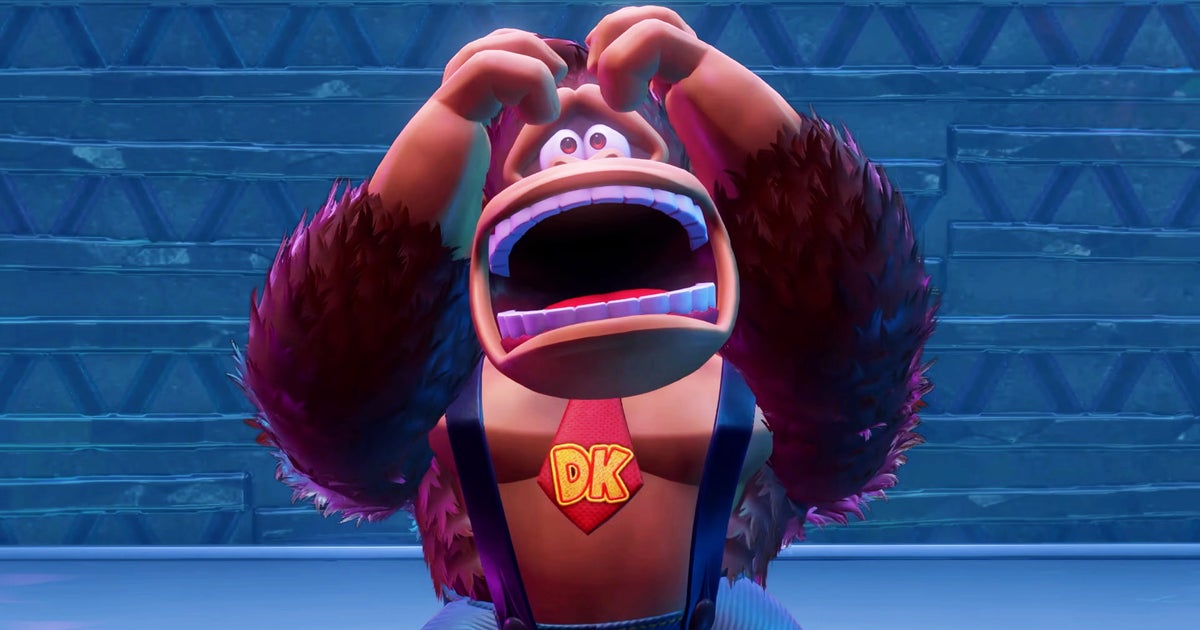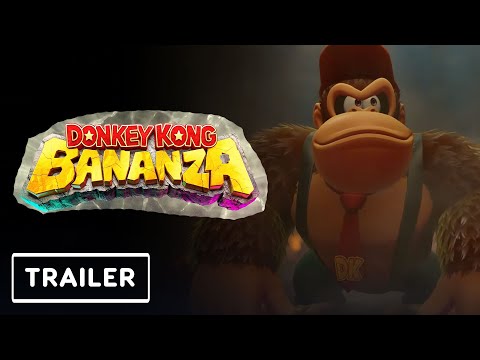To properly encapsulate how I feel about Donkey Kong Bananza, you almost have to start at the finish. No spoilers here, obviously, but I have to say that I think this game has one of the finest finales of any Nintendo game ever. There’s a delightful build-up of adrenaline as story beats and experimental mechanical evolutions are gleefully layered atop each other. It’s difficult to not have a great big smile on your face as the game hurtles towards its finish. It’s pretty masterfully done.
Bananza’s late-game spectacle feels like a direct descendant of Mario Odyssey’s wedding set piece, but also exactly the sort of thing that its new-to-Nintendo project lead might bring to the table. Bananza’s director is one Kazuya Takahashi, whose most notable previous work was on Final Fantasy 15 – another game big on spectacle. Some of that FF predilection for flair is present here, in a sense, married to a very Nintendo love for a mechanical climax over a narrative one.
So, yes. I loved that finale. My foot tapped to music during climatic fights. I grinned. I laughed out loud at some of the creative audacity on display. I sent an expletive-laden text – of the good kind – to another critic I knew was playing. I was thrilled. But I wasn’t necessarily always so en route to that finale. That, I suppose, is the story of DK Bananza. When it smashes, DK really smashes. When it doesn’t… Well, it’s no Odyssey, right?
All of this makes Bananza a tricky proposition on the review front. The truth is, I don’t really love it as much as I think I could’ve or perhaps even should’ve, excellent foundations considered. But it is excellent nevertheless.
The heart of those excellent foundations is Bananza’s destruction tech, which essentially lets DK demolish the world around him. You can’t completely flatten a level – the broad framework is set out in unbreakable material, quite often metal girders reminiscent of the original Donkey Kong’s backgrounds – but vast swathes of the terrain can be obliterated.
The whole game is built around this design. At its most basic, you might pummel your way into the ground or the side of a mountain to find a hidden collectible, which are plentiful. On a deeper level, you’re thinking about how these materials interact. There’s a hierarchy of hardness (oo-er missus) – so that means that stone will smash thorny terrain or mountains made of dirt or sand to bits, but if you want to break down concrete you’ll need a chunk of something harder like obsidian to hand.
In the same way that Breath of the Wild is the first truly ‘post-Skyrim’ Nintendo game – that is to say one which takes in the design successes of an earth-shattering rival – DK Bananza can undoubtedly be thought of as Nintendo’s latest post-Minecraft effort. But as ever with Nintendo, emulation is not enough. Everything must be pushed that little bit further.
These materials are not just about breaking down the environment, then, but are also key to enemy encounters. Each of the foes you come into contact with can appear in forms related to many of the materials, turning this tiering into a factor in combat. An enemy made from obsidian will need careful thought to defeat. One covered in thorny terrain will be impossible to punch without getting hurt, but easily crushed with another material. An enemy crafted from the highly explosive ‘boom rock’ is best viewed not as a threat, but as a walking bomb perfect to help carve out a new nook in the environment or defeat another enemy with a friendly-fire explosion.
On and on it goes, with fascinating results. As more materials with properties beyond hardiness are introduced the considerations intensify. Using the right material in the right way can open up new areas or make previously challenging encounters a breeze. In boss encounters especially, materials fly and interact with such ferocity that on a few occasions the frame rate slowed to a crawl, like when you detonate too many chunks of TNT at once in Minecraft.
It speaks to how cool these systems can be that the brief technical breakdown is instantly forgiven – systems colliding like that are well worth a bit of slowdown. The open-ended Odyssey style design where hundreds of collectibles await you means that many puzzling tasks can be completed either with their prescribed solution or by thinking wildly outside the box.
All of these materials also interact with DK’s transformations, where he can temporarily take the form of another animal like a Zebra. These are the titular ‘Bananzas’. By the late game you’re juggling it all, ripping up chunks of ground to surf on, or smash enemies with, then triggering a transformation, then seamlessly switching between transformations to dodge attacks and weave through environmental hazards, then quickly puzzling out the most efficient way to forge a path forwards… it does satisfy.
At the same time, it sometimes flounders. Bananza sees DK and new pal Pauline on a journey to the center of the planet, which means you’re digging down. Bananza’s equivalent of a ‘world’ is a ‘layer’, and rather than various forms of rock, each layer is a pretty traditional video game land. It ticks the biome boxes: mines, jungles, beaches, more fantastical offerings. It’s all here. I appreciate the flow of the game – sometimes dramatic, combat-heavy layers are immediately followed by lovely breezy chill-outs. Equally, a few layers feel like pure filler. Swings and roundabouts.
At preview, I expressed vague concerns that the smashing mechanic might not be enough to hold my interest over a full game. That concern turned out to be nonsense, because each layer introduces new materials and new lenses through which to consider DK’s destructive power. You’re bequeathed a pretty much constant flow of new stuff to do. Strangely I then had the opposite problem: there’s all this stuff, but a lot of it feels under-used. Brilliant ideas are presented, and you can’t wait to see how that mechanic will evolve… and then it just doesn’t.
This is somewhat of a theme. DK’s transformations, for instance, each have a specific utility; many puzzles will require one or another of the Bananza forms. By the same token, I’d argue a good third of the available transformations have extremely limited usefulness. A skill tree system provides useful skill unlocks for DK himself, but many of the skill upgrades for the Bananza forms feel pretty pointless. One form in particular bucks the trend – maxed out, it is a game-breaking, world-shattering monster – which is a good thing! But that only serves to underline the anemic nature of the others.
I have nitpicks beyond this. Little grumbles that are by themselves small but add up to a broader feeling that Bananza squeaks just shy of being an all-timer. For example: the way the destruction tech works means that sometimes tiny bits of material can be left behind, and are then difficult to destroy. This is fine for most of the game, but in the late game there’s a heck of a lot of super-deadly health-sapping terrain. Miss a tiny piece of this and then walk into it mid boss battle… whoops, you’re dead!
Speaking of boss battles, I don’t think there’s a single boss encounter here that isn’t repeated. Materials get swapped and all that – but when even big story bosses are trotted out multiple times, it feels a bit rote. This bit feels like a hangover from Mario, who always has boss repetition, but Bananza’s bosses are of a different stripe to Mario’s three-hit wonders. These are puzzley, spectacle-driven fights. It’s more like if a Zelda made you fight every dungeon boss twice.
There’s me complaining, then. Cry me a river. And yet: god, I really liked this game. Even as I was dying to some stupid pin prick of immensely damaging lava that I’d failed to spot, I didn’t want to put the controller down. The time just absolutely melts away. This kept me moving through the story even when events felt like they were sagging. Past the halfway point, things really begin to motor – to the point where after seeing the credits roll I was quite content to keep playing its offering of post-game challenges.
Perhaps that is where Donkey Kong Bananza best sits. It’s not the sort of seminal ‘mega wow’ game that Odyssey was. But it’s exactly the sort of experience where you can slip into a trance-like autopilot, your brain syncing up with the game’s design, and time just disappears. If it were possible to look up ‘sticky game design’ in the dictionary, it’d probably flag up a picture of Bananza.
It’s also pretty good at tugging at the heartstrings, in its way. This is a silly story about an Ape and a little girl – but it’s surprisingly heartfelt. At preview, I thought Pauline’s eager encouragement, communicated with a range of vocal barks as you smash your way through challenges, might become cloying. Instead she endears herself. There’s loads of great moments in story cutscenes, but also cute animation tics and lovely bits of dialogue whenever DK takes a nap at a rest stop to restore his health. There’s the sort of heart here that Mario has only dreamed of.
The interaction between all of the characters is genuinely lovely, in fact. I would’ve liked a little more of the legacy characters like Diddy and Dixie, but Pauline is a fabulous addition to the DK canon. I find it hard to believe that the upcoming DK film will be about anything but this pair.
Like I said, when Bananza smashes it’s totally remarkable. Occasionally it feels like it gets a bit lost, or fails to expand on some of the excellent foundations it’s laying down. That’s the sort of thing that keeps a game from being declared as a total classic for me – even if it nevertheless earns a hearty, full-throated recommendation. And even with my myriad quibbles, certainly it is the new best Donkey Kong adventure that doesn’t have the word ‘Country’ in its title – which puts it in high standing indeed.
A copy of Donkey Kong Bananza was provided for review by Nintendo.

